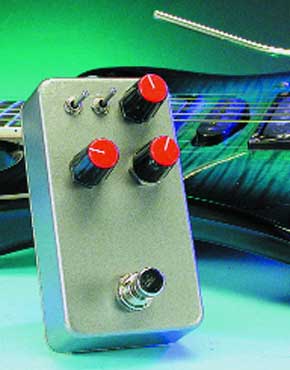Article
Tube Box
that authentic valve sound — using diodes

The Tube Box lends to a solid state amplifier that characteristic valve sound required by any self-respecting guitarist.Guitar valve (or ‘tube’) amplifiers, as used on stage or in the studio, derive their characteristic sound from the clipping behaviour of the valves when overdriven. Whereas the effect of clipping in a solid state amplifier is very unpleasant (and for many this alone is reason enough not to touch them), it is common to drive valve amplifiers into clipping. But with a disadvantage: if a valve amplifier is to be overdriven, the volume control must be turned all the way up. This does not always go down well with the other band members (or with the neighbours!). With the Tube Box circuit described here, which sits between the guitar and the valve amplifier, this is not necessary. The tiny unit applies the desired distortion to the input signal of the amplifier. The controls on the Tube Box are two potentiometers and two switches, which allow the user to choose from a wide range of possible settings, making the unit suitable for the whole spectrum of guitar music from smooth, warm blues to screaming heavy metal.
Materials
Gerber file
CAM/CAD data for the PCB referred to in this article is available as a Gerber file. Elektor GREEN and GOLD members can exclusively download these files for free as part of their membership. Gerber files allow a PCB to be produced on an appropriate device available locally, or through an online PCB manufacturing service.
Elektor recommends the Elektor PCB Service service from its business partner Eurocircuits or AISLER as the best services for its own prototypes and volume production.
The use of our Gerber files is provided under a modified Creative Commons license. Creative Commons offers authors, scientists, educators and other creatives the freedom to handle their copyright in a more free way without losing their ownership.
PCB
Component list
Resistors:
R1 = 511kOhm
R2 = 680kOhm
R3 = 6kOhm 8
R4 = 15kOhm
R5 = 1kOhm 2
R6 = 1kOhm
R7,R8,R10 = 8kOhm 2
R9,R29,R34,R35 = 2kOhm 2
R11 = 1kOhm 8
R12 = 470kOhm
R13 = 3kOhm 3
R14 = 100Ohm
R15,R26,R31 = 33kOhm
R16 = 220kOhm
R17,R21,R23 = 47kOhm
R18 = 91kOhm
R19,R20 = 43kOhm
R22 = 100kOhm
R24 = 22kOhm
R25,R33 = 68kOhm
R27 = 470Ohm
R28 = 180kOhm
R30 = 10kOhm
R32 = 5kOhm 1
P1,P2 = 100kOhm potentiometer, logarithmic law
P3= 50kOhm potentiometer, stereo, logarithmic law
Capacitors:
C1,C17,C24,C25,C26 = 100nF
C2,C3,C13,C14 = 47nF
C4,C5,C29,C30 = 10µ F 16V radial
C6 = 33nF
C7,C11 = 470pF
C8 = 1µ F 16V radial
C9 = 1µ F 16V radial
C10 = 2µ F2 16V radial
C12 = 560pF
C15 = 3nF3
C16,C27,C28 = 4nF7
C18 = 100pF
C19 = 39nF
C20 = 22nF
C21 = 220pF
C22 = 22µ F 16V radial
C23,C29,C30 = 10µ F 16V radial
Semiconductors:
D1-D4 = 1N4148
D5,D6 = LED, red
IC1,IC2,IC3 = TL072-CP*
Miscellaneous:
K1,K2 = jack socket, 6.35mm, chassis mount
K3 = solder pin
S1 = rocker switch, 1 x c/o
S2 = rocker switch, 2 x c/o
S3 = pedal switch
Enclosure: Hammond type 1590B*
PCB, order code 010119-1
R1 = 511kOhm
R2 = 680kOhm
R3 = 6kOhm 8
R4 = 15kOhm
R5 = 1kOhm 2
R6 = 1kOhm
R7,R8,R10 = 8kOhm 2
R9,R29,R34,R35 = 2kOhm 2
R11 = 1kOhm 8
R12 = 470kOhm
R13 = 3kOhm 3
R14 = 100Ohm
R15,R26,R31 = 33kOhm
R16 = 220kOhm
R17,R21,R23 = 47kOhm
R18 = 91kOhm
R19,R20 = 43kOhm
R22 = 100kOhm
R24 = 22kOhm
R25,R33 = 68kOhm
R27 = 470Ohm
R28 = 180kOhm
R30 = 10kOhm
R32 = 5kOhm 1
P1,P2 = 100kOhm potentiometer, logarithmic law
P3= 50kOhm potentiometer, stereo, logarithmic law
Capacitors:
C1,C17,C24,C25,C26 = 100nF
C2,C3,C13,C14 = 47nF
C4,C5,C29,C30 = 10µ F 16V radial
C6 = 33nF
C7,C11 = 470pF
C8 = 1µ F 16V radial
C9 = 1µ F 16V radial
C10 = 2µ F2 16V radial
C12 = 560pF
C15 = 3nF3
C16,C27,C28 = 4nF7
C18 = 100pF
C19 = 39nF
C20 = 22nF
C21 = 220pF
C22 = 22µ F 16V radial
C23,C29,C30 = 10µ F 16V radial
Semiconductors:
D1-D4 = 1N4148
D5,D6 = LED, red
IC1,IC2,IC3 = TL072-CP*
Miscellaneous:
K1,K2 = jack socket, 6.35mm, chassis mount
K3 = solder pin
S1 = rocker switch, 1 x c/o
S2 = rocker switch, 2 x c/o
S3 = pedal switch
Enclosure: Hammond type 1590B*
PCB, order code 010119-1


Discussion (0 comments)